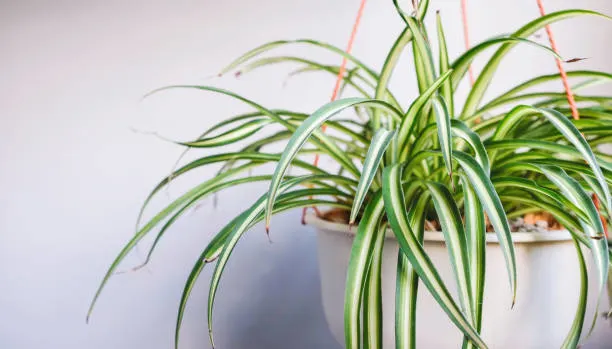Introduction
Spider plants (Chlorophytum comosum) are beloved for their striking green and white variegated leaves and low-maintenance care. Beyond their aesthetic appeal, spider plants offer a range of benefits that make them a fantastic addition to any home or office. From improving air quality to boosting well-being, this blog explores the many advantages of spider plants and why they’re a top choice for plant enthusiasts.
1. Air Purification
One of the most well-known spider plant benefits is its ability to purify indoor air. According to studies, including NASA’s Clean Air Study from the 1980s, spider plants can remove harmful toxins like:
- Formaldehyde
- Benzene
- Carbon monoxide
- Xylene
These pollutants are commonly found in household items like furniture, carpets, and cleaning products. By absorbing these toxins and releasing oxygen, spider plants help create a healthier indoor environment, which is especially beneficial for those with respiratory issues or allergies.
2. Easy to Care For
Spider plants are perfect for both novice and experienced plant owners due to their low-maintenance nature. Here’s why they’re so easy to care for:
- Light: They thrive in indirect light but can tolerate low light or even some direct sun.
- Watering: They need moderate watering, typically once a week, and are forgiving if you occasionally forget.
- Soil: They adapt to most soil types, as long as it’s well-draining.
- Propagation: Spider plants produce “spiderettes” (baby plants) that can be easily propagated by planting them in soil or water.
Their resilience makes them ideal for busy individuals or those new to plant care.
3. Pet-Safe and Non-Toxic
For pet owners, spider plants are a safe choice. According to the ASPCA, spider plants are non-toxic to dogs, cats, and other pets. While eating large amounts may cause mild digestive upset in pets, they pose no serious health risks. This makes them a worry-free option for households with curious animals.
4. Stress Reduction and Mental Health Benefits
Having plants like spider plants in your living space can positively impact mental health. Research shows that indoor plants can:
- Reduce stress and anxiety
- Improve mood
- Enhance focus and productivity
The lush greenery of spider plants adds a calming, natural element to any room, making them perfect for creating a serene atmosphere in homes or workspaces.
5. Aesthetic Versatility
Spider plants are visually appealing and versatile, fitting into various decor styles:
- Hanging Baskets: Their cascading leaves look stunning in hanging planters.
- Shelves or Stands: They add a pop of green to bookshelves or plant stands.
- Minimalist Decor: Their simple yet elegant look complements modern, minimalist aesthetics.
Their adaptability makes them a favorite for interior designers and home decorators alike.
6. Humidity Regulation
Spider plants can help regulate indoor humidity levels. Their leaves release moisture through transpiration, which can be beneficial in dry climates or during winter when indoor heating reduces humidity. This makes them a great choice for maintaining a comfortable environment, especially for those with dry skin or respiratory sensitivities.
7. Cost-Effective and Sustainable
Spider plants are affordable and sustainable. They’re widely available at garden centers, and their ability to produce spiderettes means you can propagate new plants for free. This makes them a budget-friendly way to expand your plant collection or share with friends. Plus, their air-purifying qualities contribute to a healthier, eco-friendly home.
8. Educational Value for Kids
Spider plants are a great way to introduce children to gardening. Their fast-growing spiderettes and easy propagation process make them an engaging tool for teaching kids about plant life cycles, responsibility, and environmental care. Watching a spiderette grow into a full plant can be a rewarding experience for young learners.
How to Maximize Spider Plant Benefits
To fully enjoy the benefits of spider plants, follow these care tips:
- Place in Indirect Light: Position your plant near a window with filtered light for optimal growth.
- Water Moderately: Keep the soil moist but not waterlogged. Overwatering can lead to root rot.
- Prune Regularly: Trim yellowing leaves to encourage healthy growth.
- Propagate Spiderettes: Cut off baby plants and root them in water or soil to expand your collection.
- Clean Leaves: Wipe leaves with a damp cloth to remove dust and enhance air purification.

Potential Drawbacks to Consider
While spider plants are generally low-risk, there are a few things to keep in mind:
- Overwatering: Too much water can cause root rot, so ensure proper drainage.
- Pest Attraction: Spider plants may occasionally attract pests like spider mites. Regular inspection and neem oil can help.
- Space Needs: Their long leaves and spiderettes may require ample space, especially in hanging baskets.
Conclusion
Spider plants are more than just a pretty addition to your home—they’re a powerhouse of benefits. From purifying the air to reducing stress and being pet-safe, these versatile plants are a must-have for anyone looking to enhance their living space. Their easy care and propagation make them accessible to all, while their aesthetic and health benefits add value to any environment.



